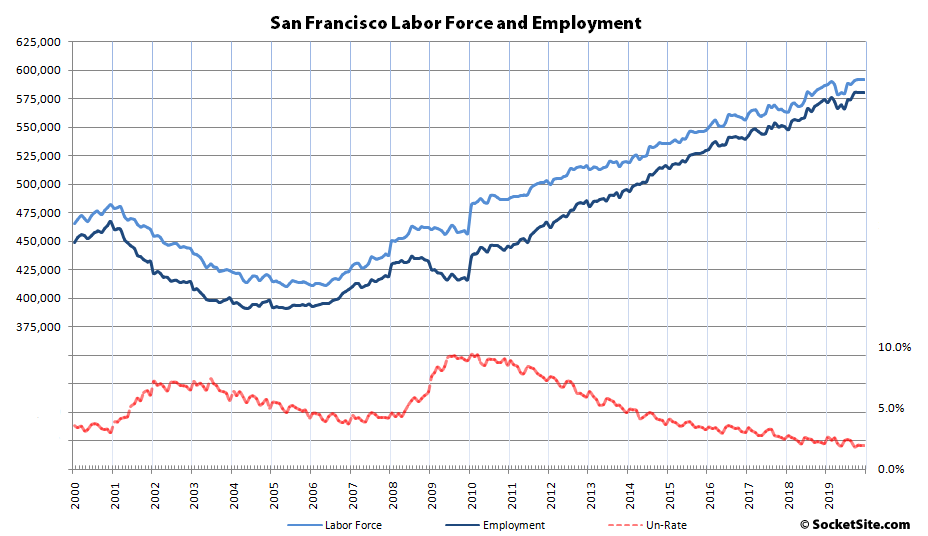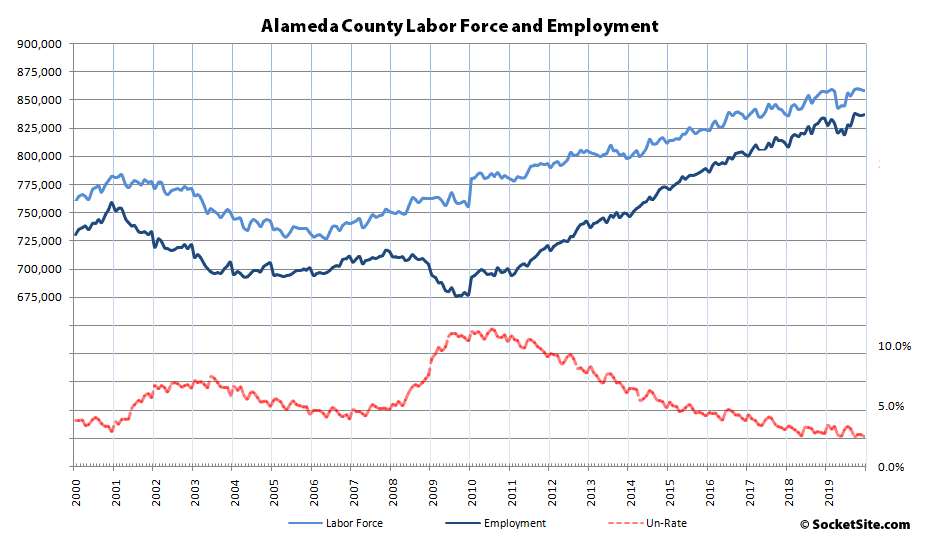The number of people living in San Francisco with a paycheck was effectively unchanged from November to December and is now holding around a record 580,000 with an unemployment rate of 1.9 percent.
As such, there are now 6,200 more people living in the city with paychecks than there were are the same time year and 143,700 more employed than in January of 2010. But the year-over-year gain in December employment was the smallest in a decade and significantly down from a gain of 24,200 the year before.
At the same time, the estimated number of employed people living in Alameda County, which includes the City of Oakland, inched up by 700 to 837,100 at the end of last year, representing a year-over-year gain of 3,500 with an unemployment rate of 2.5 percent. But that’s versus a year-over-year gain of 21,000 at the end of 2018.
Across the greater East Bay, including Solano County, total employment inched up by 400 in December to 1,593,400, which is 3,300 above its mark at the same time last year versus a year-over-year gain of 38,100 at the end of 2018.
Up in Marin, the number of employed residents is holding at around 140,000, which is 800 higher than at the same time last year, versus a year-over-year gain of 3,700 in December of 2018, with an unemployment rate of 1.9 percent. Employment in Napa dropped by 1,300 to 70,700 but remains above its mark at the same time last year by a total of 700 employed. And Employment in Sonoma County inched up by 700 to 256,400, which was 1,200 higher on a year-over-year basis.
Down in the valley, employment in San Mateo County held at 458,900 in December, which is 4,500 higher than at the same time last year but versus a year-over-year gain of 18,900 in December of 2018, and increased by 1,900 in Santa Clara County to 1,050,600, which is 16,600 higher on a year-over-year basis versus a year-over-year gain of 26,000 in December of 2018, with unemployment rates of 1.8 percent and 2.2 percent respectively.
And as such, total employment across the Bay Area inched up by 1,800 in December to 4,150,600, which does represent a year-over-year gain of 33,200, but that’s versus a year-over-year gain of 117,000 at the end of 2018 and the smallest year-over-year gain at the end of the year since 2009, with an unemployment rate 2.3 percent.


Maybe a good way to summarize, Bay area employment is that it has hit the Housing Ceiling with really no room left in the current workforce to substantially increase the employment numbers so unless a large amount of affordable housing were somehow to magically appear don’t count on getting much higher.
Keep in mind that housing production remains positive. But for the first time in a decade, net migration has turned negative across the Bay Area and the adult population in San Francisco has dropped.
1. How do we add more jobs faster?
This is not the right question to ask. Plenty of jobs are being created, it’s just that the majority of them are (largely service) jobs which don’t pay wages commensurate with the cost of living in San Francisco or even the Bay Area in general. The primary driver of that cost of living being out of whack given the relatively low wages the majority of the newly-created jobs pay being the cost of housing.
The right question to ask is how public policy can balance the population load with the supply of housing which is affordable to the population that is here.